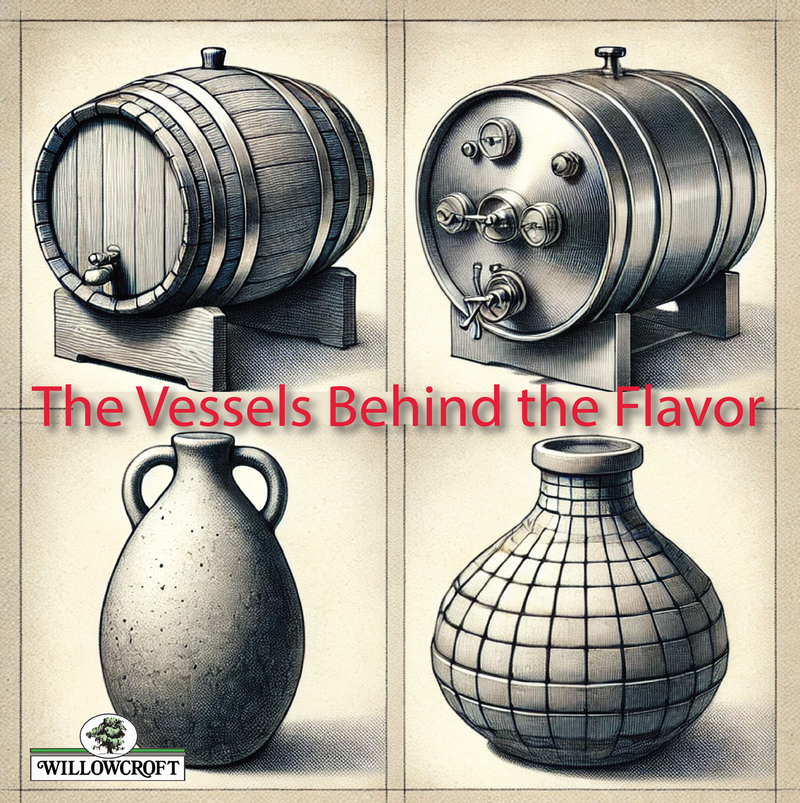News
Welcome to the Willowcroft blog! This is where we will be highlighting events and news from around the winery.
Elevate Your Home Wine Tasting: Tips for a Memorable Experience with Willowcroft Wines
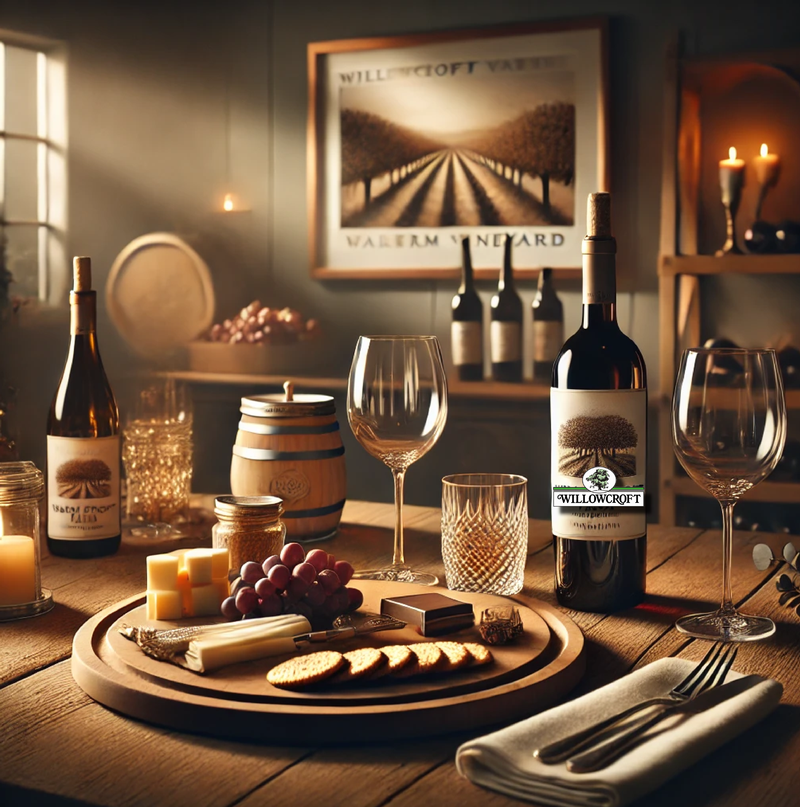
Elevate your home wine-tasting experience by incorporating selections from Willowcroft Farm Vineyards, Loudoun County's original winery. Here's how to create an engaging and educational tasting event:
- 1. Choose a Theme
Selecting a theme gives structure to your tasting. Consider:
- 🎨 Varietal Exploration: Compare wines made from the same grape grown in different regions.
- 🌎 Regional Focus: Showcase wines from a specific country or area.
- 🕰️ Aging Process: Taste the difference between young and aged wines.
- 2. Curate Your Wine Selection
Select a mix of white, red, and perhaps a sparkling or dessert wine. For example:
- 🍇 A crisp Seyval
- 🍷 A smooth Chambourcin
- 🌟 A refreshing sparkling wine
- 3. Prepare the Tasting Environment
- 🥂 Glassware: Use clear wine glasses, ideally one for each wine.
- 🍞 Palate Cleansers: Offer plain crackers or unsalted bread to reset between sips.
- ✨ Ambiance: Set the mood with soft lighting, candles, and a clean table or counter for serving.
- 4. Pair with Complementary Foods
Enhance the tasting with simple, versatile pairings:
- 🧀 Seyval: Goat cheese or feta
- 🧀 Chambourcin: Gruyere or mushroom-based dishes
- 🧀 Cabernet Sauvignon: Aged cheddar or blue cheese
- 🍫 Dessert Wine: Dark chocolate or berry desserts
- 5. Make It Interactive
- ✍️ Tasting Notes: Provide small cards or notebooks for guests to jot down their impressions.
- 🕶️ Blind Tastings: Cover labels and let guests guess the wine’s varietal or origin.
- 🎉 Friendly Competition: Reward the best guesser with a bottle of wine!
- 6. Share the Experience
- Take photos of your setup and pairings, and tag your favorite local winery (like Willowcroft Farm Vineyards!) to spread the word about supporting local producers.
By creating a thoughtful and fun environment, you can transform your home wine-tasting into an experience that’s both enjoyable and educational. Cheers to making memories, one glass at a time!
The Terroir Connection: How Soil Shapes the Flavor and Quality of Wine
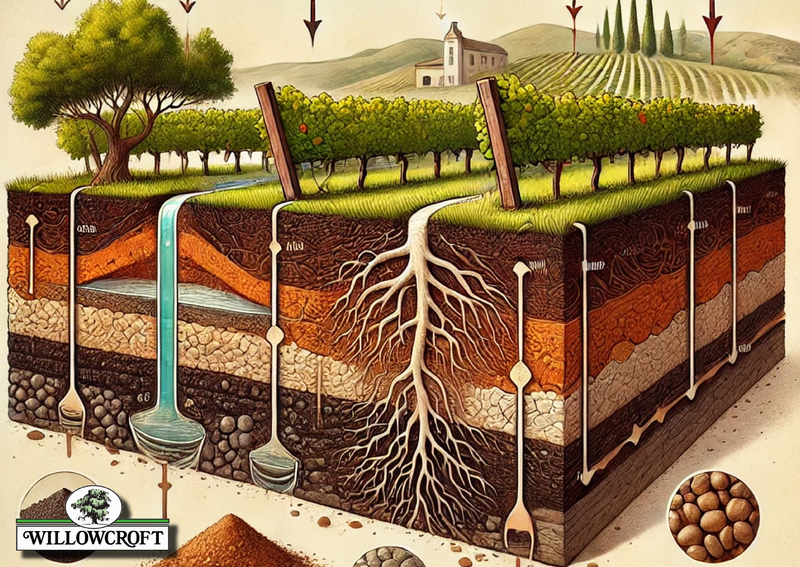 The soil in which grapevines grow plays a crucial role in winemaking, influencing everything from water management to the flavors in the final product. Understanding soil characteristics can help vintners decide to cultivate healthy vines and produce quality wines.
The soil in which grapevines grow plays a crucial role in winemaking, influencing everything from water management to the flavors in the final product. Understanding soil characteristics can help vintners decide to cultivate healthy vines and produce quality wines.
Particle Size, Drainage, and Water Retention
Soil texture—defined by the proportion of sand, silt, and clay—affects water drainage and retention, which are vital for vine health. Sandy soils have larger particles and larger pore spaces, allowing for quick drainage but limited water retention. Conversely, clay soils consist of smaller particles and smaller pore spaces, leading to slower drainage and higher water retention. Loam soils, which are a balanced mix of sand, silt, and clay, offer moderate drainage and water-holding capacity, often considered ideal for viticulture. The right balance ensures that vine roots receive adequate moisture without becoming waterlogged, promoting deep root growth and resilience.
Soil Color, Sun Reflection, and Heat Absorption
The color of soil can influence its temperature by affecting how it absorbs and reflects sunlight. Darker soils tend to absorb more heat, which can be beneficial in cooler climates by promoting earlier ripening of grapes. Lighter-colored soils, such as those rich in limestone or chalk, reflect more sunlight, potentially keeping the soil cooler and delaying ripening. This reflection can also enhance light exposure to the grape clusters, aiding in photosynthesis. Managing soil temperature through color and composition helps vintners control the ripening process and grape development.
Soil Composition and Flavor Influence
Beyond texture and color, the mineral composition of soil can subtly influence the flavor profile of wines. For instance, calcareous soils, which are rich in calcium carbonate, are known to retain water effectively and can impart a certain acidity to the grapes, contributing to a wine's freshness. Clay soils, with their excellent water retention, can produce bold and structured wines, making them suitable for varieties like Merlot and Sangiovese. While the direct impact of soil minerals on wine flavor is complex and not fully understood, the interplay between soil composition, water availability, and vine health undeniably shapes the characteristics of the wine.
In summary, a deep understanding of soil properties—including particle size, color, and composition—enables winemakers to optimize vine health and influence the sensory qualities of their wines.
From Snow to Bud Break: The Promise of a New Season in Northern Virginia Vineyards
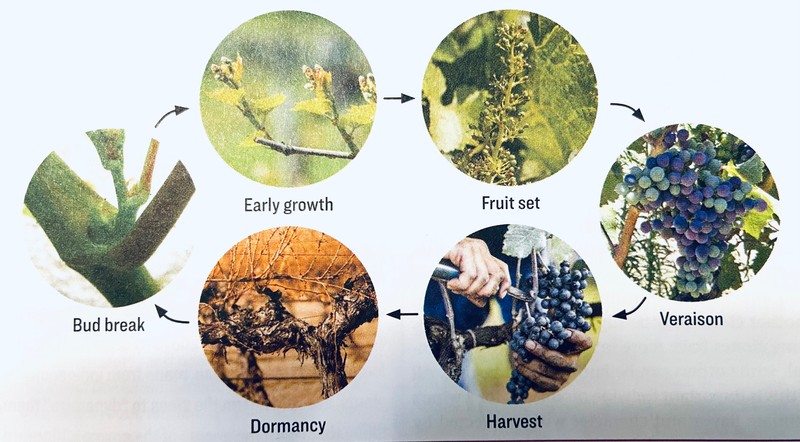
Northern Virginia has been blanketed by more snow and colder temperatures than usual as we find ourselves in the heart of winter. Notably, early January brought significant snowfall, with areas like Leesburg receiving more than 7 inches. While the landscape rests under this frosty veil, it's heartening to remember that the vineyards will begin their annual renewal in just about six weeks.
Grapevines are dormant, appearing as mere woody twigs amidst the snow. This essential period allows vines to conserve energy and prepare for the upcoming growth cycle. As temperatures start to rise and the ground begins to thaw, the first signs of life emerge with bud break. Tiny buds swell and burst open, revealing new shoots and leaves, marking the vine's reawakening.
Following bud break, the vines enter a phase of rapid growth. Shoots lengthen, and small, self-pollinating flowers appear. These blossoms, once pollinated, develop into tiny green berries. As summer progresses, these berries undergo veraison, changing color and beginning to ripen. The grapes reach their peak ripeness by late summer to early fall, ready for harvest.
The current winter conditions, though harsh, play a crucial role in this cycle. The cold ensures that vines remain dormant, protecting them and allowing for a more synchronized and healthy bud break come spring. So, as we navigate these chilly days, take comfort in knowing that the vineyards are merely resting, gathering strength for a vibrant season ahead. In just a few weeks, we'll witness the first signs of this transformation, a testament to nature's resilience and the promise of warmer days.
Starting Your Wine Collection: A Guide to Building a Personal Cellar

Starting a wine collection can be rewarding, offering financial benefits, enhanced appreciation of wine, and enriched social experiences. By purchasing wines with a cellar mindset, you diversify your selection, exploring unfamiliar varieties alongside your favorites. This approach deepens your understanding of the wine world's diversity and can lead to discovering new preferences. Additionally, a well-curated collection may appreciate in value over time, providing potential financial returns.
Proper storage is crucial to maintain the quality and longevity of your wines. Options include wine racks, wine fridges, and dedicated wine cellars. Wine racks are suitable for short-term storage in cool, dark spaces but lack temperature and humidity control. Wine fridges offer precise temperature settings and often include UV protection and vibration control, making them ideal for medium-term storage. A wine cellar with consistent temperature and humidity control is optimal for long-term aging. The choice among these depends on your collection size, budget, and available space.
When selecting wines to collect, consider both renowned regions and emerging ones. Iconic wines from Burgundy, Bordeaux, Barolo, and Napa Valley are esteemed but can be expensive. Alternatively, affordable options from regions like Willamette Valley, Loire Valley, Finger Lakes, and, of course, Virginia offer excellent aging potential and unique flavors. Exploring these areas allows you to build a diverse collection without exceeding your budget.
Keeping track of your collection is essential for organization and ensuring optimal consumption times. Digital tools like CellarTracker or VinoVoss provide user-friendly platforms to catalog your wines, track their aging progress, and record tasting notes. For a cost-effective solution, a simple Excel spreadsheet can effectively manage your inventory. Regular updates and meticulous record-keeping will help you decide when to enjoy each bottle.
Embarking on a wine collection journey enhances your enjoyment and understanding of wine. With thoughtful selection, proper storage, and diligent management, your collection will reflect your tastes and provide lasting satisfaction.
To conclude, here are some practical tips to enhance your wine collection journey:
- Define Your Purpose and Budget: Clarify whether you're collecting for personal enjoyment, investment, or social occasions. Establish a budget that aligns with your goals to guide your purchasing decisions.
- Educate Yourself: Expand your wine knowledge by attending tastings, reading reputable sources, and engaging with wine communities. This will inform your selections and deepen your appreciation.
- Start Small and Diversify: Begin with a modest collection, focusing on wines you enjoy. Gradually introduce varieties from different regions and grape types to broaden your palate.
- Invest in Proper Storage: Ensure your wines are stored in optimal conditions—cool, humid, and away from light and vibrations—to preserve their quality over time.
- Keep Detailed Records: Maintain an inventory of your collection, noting purchase dates, prices, and tasting notes. This practice aids in tracking the aging process and planning future acquisitions.
- Be Patient and Enjoy the Journey: Wine collecting is a long-term endeavor. Allow wines to mature, and savor the experience of discovering and sharing new favorites.
Grapes Are the GOAT for Winemaking: Here’s Why!
 When crafting the perfect wine, no fruit does it better than grapes. They are the true GOAT (Greatest of All Time) in winemaking. While it’s possible to make wine from fruits like blueberries, apples, peaches, or cherries, grapes—especially Vitis vinifera—are uniquely equipped by nature to create balanced, complex, and truly magical wines. Here’s why grapes outshine the rest: winemakers have relied on them for thousands of years.
When crafting the perfect wine, no fruit does it better than grapes. They are the true GOAT (Greatest of All Time) in winemaking. While it’s possible to make wine from fruits like blueberries, apples, peaches, or cherries, grapes—especially Vitis vinifera—are uniquely equipped by nature to create balanced, complex, and truly magical wines. Here’s why grapes outshine the rest: winemakers have relied on them for thousands of years.
The Perfect Balance: Sugar, Acidity, and Tannins
Grapes are the ultimate multitaskers when it comes to winemaking because they naturally contain the perfect trifecta:
- Sugar: Fully ripe vinifera grapes boast just the right amount of sugar (20-30%) for yeast to convert into alcohol during fermentation. Other fruits often require additional sugar (a process called chaptalization) to achieve the same results.
- Acidity: Grapes have just enough acidity to balance out their sweetness, giving wines a structured and refreshing flavor. Acidity also acts as a natural preservative, ensuring the wine ages gracefully.
- Tannins: Found in grape skins and seeds, tannins provide the backbone of wine’s structure and contribute to its ability to age. Most other fruits, like apples or blueberries, lack significant tannin levels, resulting in less complex wines.
With grapes, winemakers can create wines that range from sweet and aromatic to dry and bold—all without having to artificially adjust sugar, acid, or tannins.
Nature Knows Best: Grapes Are Self-Sufficient
Grapes are a winemaker’s dream because they come ready to ferment. The natural yeast found on grape skins initiates the fermentation process, while the fruit provides the nutrients yeast needs to thrive.
In ancient times, winemakers needed little more than ripe grapes and a vessel to let nature work its magic. Crush the grapes, let the yeast ferment the sugars, and voilà—wine. All humans had to do was keep it from turning into vinegar. Few other fruits offer this effortless balance, so grapes have remained the gold standard for winemaking throughout history.
Complexity and Versatility in Every Sip
Grapes can remarkably reflect the terroir (the environment in which they’re grown), creating a diverse range of flavors and styles. Grapes can do everything from bold, tannic reds to crisp, aromatic whites and sparkling wines.
While fruit wines made from apples, blueberries, or peaches can be delicious, they often lean toward sweetness and lack the complexity of grape-based wines. Grapes’ unique balance of sugar, acidity, and tannins allows for layers of flavor and aromas that evolve, giving each bottle its own story.
A History Rooted in the Vine
Vinifera grapes have been the foundation of winemaking for over 8,000 years, originating in the regions around modern-day Georgia and Armenia. Early winemakers quickly realized that grapes were the perfect fruit for creating wine with minimal intervention.
As winemaking techniques evolved, grapes remained central to this ancient art. From the rolling hills of Tuscany to the valleys of Napa, grapes have become synonymous with wine, thanks to their unparalleled ability to produce balanced, complex, and age-worthy vintages.
Why Other Fruits Fall Short
While you can make wine from fruits like apples, blueberries, or cherries, these fruits often require extra help to achieve balance:
- Sugar Boosts: Many fruits don’t contain enough sugar for fermentation, requiring added sugar.
- Acidity Adjustments: Most fruits lack the natural acidity needed for a well-structured wine.
- Tannin Additions: Fruit wines often taste flat or overly sweet without the tannins found in grape skins and seeds.
Even some native North American grapes, like Concord, lack the ideal balance of sugar, acid, and tannins, requiring winemakers to make adjustments to produce high-quality wine.
Preservation and Aging Potential
Grapes are uniquely suited for creating wines that improve over time. Their acidity and tannins act as natural preservatives, allowing wines to develop new flavors and aromas as they age. Most fruit wines, by contrast, are best enjoyed young, as they lack the structure to evolve significantly in the bottle.
The Bottom Line: Grapes Are the GOAT
Grapes are truly the GOAT for winemaking because they provide everything needed to create exceptional wines—sugar for fermentation, acidity for balance, tannins for structure, and the natural yeast and nutrients that make fermentation possible.
So, the next time you raise a glass, toast to the humble grape—the real MVP behind every great bottle of wine. Cheers to nature’s perfect fruit for winemaking!
Charcuterie & Wine: A Perfect Pairing for Any Occasion
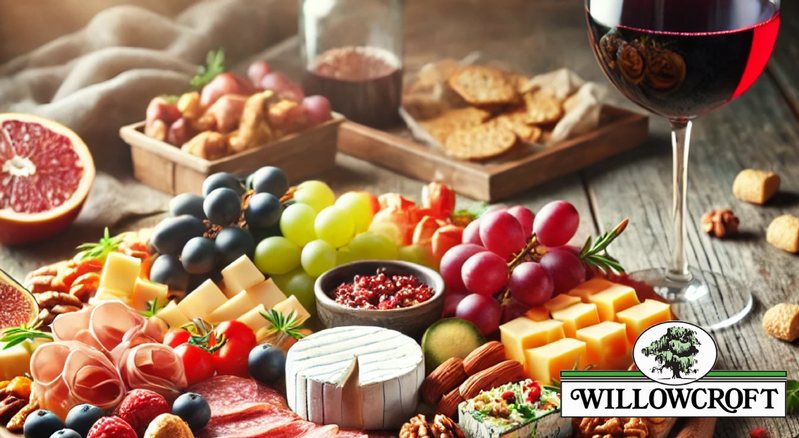
Charcuterie and wine are the ultimate duo for entertaining or enjoying a cozy evening at home. The harmony between the flavors, textures, and aromas of these two indulgences creates a sensory experience that’s as delicious as it is memorable. But what makes charcuterie and wine such a perfect pair? It’s all about balance and enhancement.
Pairing Tips for the Perfect Match
- Salty and Savory: The saltiness of cheese, especially hard or aged varieties, enhances the fruit aromas of light-bodied or sparkling white wines. Try pairing a crisp Seyval Blanc or a sparkling Albarino with a sharp cheddar or Parmesan for a delightful contrast.
- Rich Meats & Nuts: Cured meats like prosciutto or salami, alongside roasted nuts, beautifully counterbalance the tannins in bold red wines. Willowcroft’s Petit Verdot, with its deep and complex profile, is an ideal match for these rich flavors.
- Bright, Acidic Wines: Creamy cheeses, such as Brie or Camembert, benefit from the freshness of bright, acidic wines. An off-dry Riesling or our signature Muscat Ottonel can cut through the richness, creating a refreshing and smooth finish.
- Pâté Perfection: Coarse, rustic pâtés shine alongside earthy reds like Cabernet Franc, bringing out their earthy undertones. For a more delicate pâté, consider a silky Chardonnay Reserve to soften its intensity.
- Stay Local: A fantastic rule of thumb is to pair wines and cheeses from the same region. For instance, our Chambourcin pairs wonderfully with regional cheeses and meats, offering a taste of Virginia in every bite.
Building the Ultimate Charcuterie Board
Crafting a visually stunning and delicious charcuterie board is an art form. Here are some tips to elevate your spread:
- Variety is Key: Include different textures, milk types (cow, goat, sheep), and cured meat styles to cater to diverse palates.
- Play with Shapes & Colors: Get creative with how you slice and arrange items to make your board a feast for the eyes.
- Add Freshness: Fruits like figs, grapes, or apples and colorful veggies like roasted peppers or radishes add a vibrant touch.
- Ready-to-Eat: Choose foods that are easy to nibble on, like crackers, breadsticks, or nuts, ensuring guests can enjoy without extra prep.
Willowcroft Wines to Complement Your Board
- For Spicy and Smoky Flavors: Pair Manchego cheese, chorizo, and smoky roasted peppers with Muscat Ottonel or Riesling. Their fruity and off-dry notes balance out the bold, spicy flavors.
- For Hearty and Bold Pairings: Combine dark chocolate, Italian cured meats, and mixed nuts with our rich Petit Verdot. Its robust profile enhances the deep, savory elements of these foods.
At Willowcroft, we believe the best pairings come from experimenting with flavors and enjoying the journey. Stop by the tasting room to explore our wines and discover your favorite charcuterie combinations. Cheers to elevating your next wine and charcuterie experience!
How Long Is Red Wine Good for After Opening?

Wine lovers know that savoring a great bottle of red wine is an enjoyable experience. But once that cork is popped, the countdown begins. Unlike sealed bottles, open wine doesn’t age gracefully—it starts to deteriorate as oxygen interacts with it. The good news? With proper storage, you can extend the life of your red wine and enjoy every last drop.
The Lifespan of Open Red Wine
On average, an open bottle of red wine will last 3 to 5 days, but its longevity depends on factors like tannin levels, acidity, and storage. Higher-tannin wines like Cabernet Sauvignon and Syrah stay fresher longer than low-tannin reds like Pinot Noir or Grenache.
Some wines can taste even better the day after opening, as exposure to air can help them "open up" and develop their flavors. However, after a few days, most wines lose their vibrancy and eventually turn into something resembling vinegar.
How to Store Open Red Wine
To maximize the lifespan of your open bottle, follow these simple tips:
- Re-Cork It: Seal the bottle with its original cork or a wine stopper as soon as possible after pouring.
- Cool It Down: Store the bottle in a cool, dark place, like a wine fridge or your regular refrigerator. Cooler temperatures slow the oxidation process, helping the wine stay fresher for longer.
- Warm It Up Before Serving: If you’ve stored your red in the fridge, let it sit out for 10–15 minutes before pouring. This brings it closer to its ideal serving temperature.
- Consider the Wine Type: Wines with high tannin and acidity naturally last longer. Keep this in mind when selecting a wine to open if you don’t plan to finish the bottle right away.
Bonus Tip: Small Amounts? Decant and Store
If you have only a little wine left, transfer it to a smaller, airtight container to reduce the surface area exposed to oxygen. This can help preserve the wine’s quality for an extra day or two.
Enjoy Every Sip
Wine is meant to be enjoyed, and you can make the most of your open bottle with a little care. Whether it’s a bold Cabernet or a delicate Pinot Noir, storing it properly ensures you don’t miss a moment of its flavor and complexity. Cheers to making every sip count! 🍷
Can You Bring Willowcroft Wine on a Plane? Yes, Here’s How!
Traveling with wine is a great way to share your favorite Willowcroft vintages with friends and family or to savor them yourself at your destination. The good news is that you can bring wine on your flights, but knowing the rules is important before you pack. Here’s what you need to know about taking wine when you fly.
Carry-On Restrictions
- If you’re hoping to carry wine in your hand luggage, it must follow TSA’s liquid rule: bottles must be 3.4 ounces (100 milliliters) or less and fit into a single clear, quart-sized, zip-top bag. Since most wine bottles far exceed this size, carrying wine onto the plane isn’t typically an option.
Checked Luggage Guidelines
Bringing wine in your checked luggage is more flexible:
- Alcohol Content 24%-70%: You can bring up to 5 liters (1.3 gallons) of alcohol per passenger. The wine must be in its unopened retail packaging.
- Alcohol Content Less Than 24%: For most wines, there’s no limit, but keep in mind that Customs may tax large quantities, typically anything over 12 bottles (one case).
- Alcohol Content Greater Than 70%: These beverages are prohibited due to their classification as hazardous materials.
Practical Tips for Traveling with Wine
- Check with Your Airline: Some airlines may have additional restrictions on carrying alcohol, so it’s always best to confirm their policies.
- Protect Your Bottles: Use a wine transport bag like WineSkin or similar bubble wrap-style protectors to prevent breakage or leakage during your journey.
- Duty-Free Purchases: If you buy wine after clearing airport security, carrying it onto the plane is fine. However, if you have a connecting flight within the U.S., you must place it in your checked baggage before your next flight.
- Follow FAA Rules: Remember, you can’t drink alcohol onboard unless a flight attendant serves it.
Crossing Borders with Wine
- If you’re flying internationally, U.S. Customs and Border Protection (CBP) allows wine in your luggage, but carrying more than a case may attract extra scrutiny or taxes. Always declare your wine at customs to avoid complications.
Enjoy Willowcroft Wine Anywhere!
- With these tips in mind, you can safely bring your favorite Willowcroft wines wherever you go. Whether it’s a bottle of Seyval Blanc for a sunny beach picnic or Chambourcin for a cozy holiday dinner, we’re thrilled to be part of your adventures.
Safe travels, and cheers to Willowcroft on the go! 🍷
Aging Wine: The Vessels Behind the Flavor
The vessel in which wine ages is more than just a container—it's a defining factor in a wine's final taste, texture, and personality. Each aging vessel offers unique characteristics that influence the wine's development, from the traditional oak barrel to the modern stainless steel tank and the resurgent concrete fermentor. Here's a breakdown of the most popular options and what they bring to the table.
Stainless Steel: Purity and Precision
Stainless steel is a favorite for winemakers crafting bright, fruit-forward wines, particularly whites and rosés. Its impermeable surface seals the wine from oxygen, preserving its freshness and acidity. Stainless steel’s neutral profile ensures no external flavors are introduced, making it ideal for showcasing varietal purity. Durable, cost-effective, and often equipped with temperature controls, it’s a practical choice for young wines celebrating their natural fruit expression.
Oak: Depth and Complexity
Oak barrels have long been a hallmark of winemaking, adding layers of complexity to reds and some whites. Their porous nature allows for micro-oxygenation, which softens tannins and acidity, creating a smoother mouthfeel. The type of oak (e.g., French, American, or Slavonian), the barrel's age, and its size all play critical roles. New oak contributes prominent flavors like vanilla, spice, and toast, while older, neutral barrels offer subtler effects. While oak barrels can be expensive and labor-intensive to maintain, their ability to impart both structure and character to wine is unmatched.
Concrete: Balance and Elegance
Concrete fermentors strike a middle ground between the neutrality of stainless steel and the oxygen interaction of oak. Though they don't impart flavor, their porous walls allow for micro-oxygenation, subtly softening tannins and acidity. The even temperature regulation provided by concrete’s thick walls is another plus. Egg-shaped concrete vessels, in particular, have gained popularity for their ability to keep wine particles in constant motion, enhancing texture and integration.
Clay Amphora: Ancient Innovation
Clay amphorae, reminiscent of ancient Roman winemaking, are experiencing a modern revival. Like concrete and oak, their porous nature enables micro-oxygenation, while their distinctive shape promotes natural circulation. Amphorae are favored by winemakers seeking to highlight earthy, traditional flavors while preserving the wine's natural essence.
Choosing the Right Vessel
Ultimately, the choice of the aging vessel depends on the winemaker's vision. Stainless steel champions purity, oak adds complexity and concrete or clay bridges the gap for balanced refinement. Each vessel serves as a tool and an art form, helping craft wines that tell their own story in the glass. Whether you're sipping a crisp Sauvignon Blanc aged in stainless steel or a velvety Merlot from oak, the vessel is the silent partner in the wine’s journey from grape to glass.
Holiday Gift Giving for Wine Lovers: Beyond the Bottle
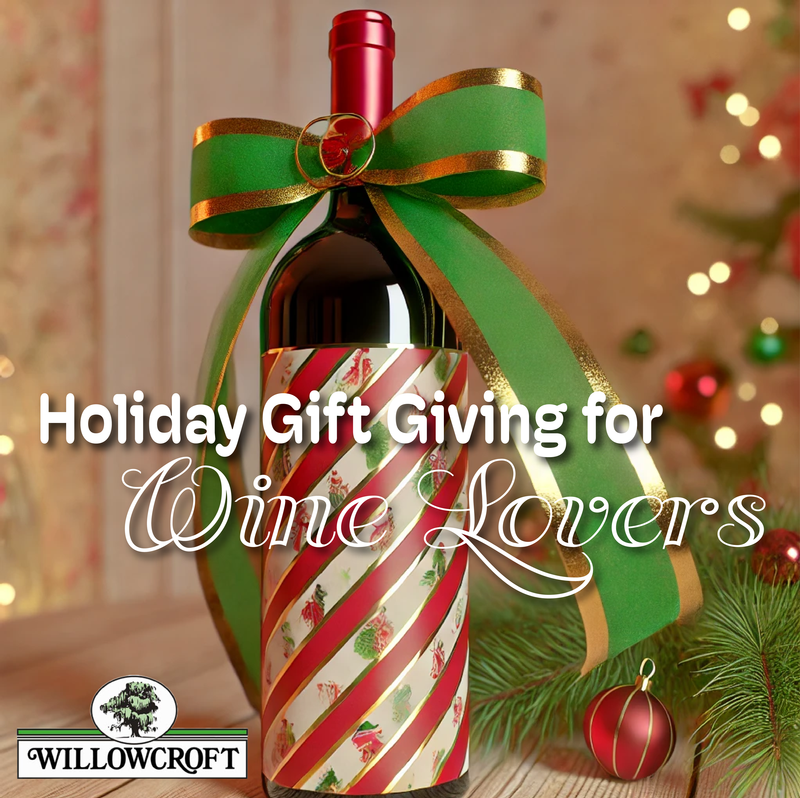
As the holiday gift-giving season begins, finding the perfect gift for the wine lover in your life doesn’t have to stop at a great bottle. With so many accessories and experiences to enhance their enjoyment, wine-themed gifts can go from thoughtful to unforgettable. Here’s a guide to gift ideas based on price range, interest level, and a few helpful considerations.
For Casual Wine Drinkers
If they’re new to wine or enjoy it casually, keep it fun and functional:
- Wine Glass Charms – Add a bit of flair to their glassware with quirky charms that make entertaining easier.
- Stylish Wine Stopper – Perfect for preserving an opened bottle with a touch of elegance.
- Compact Wine Chiller Bucket – Keep wines cool in style, especially useful for whites or sparkling varieties.
- Personalized Wine Bottle Opener – Make a simple tool special with personalization.
- Wine-Themed Cookbook – Inspire them with pairing ideas and recipes designed to enhance their wine experience.
For Serious Wine Enthusiasts
For the avid wine lover who takes their hobby seriously, these elevated choices make ideal gifts:
- High-End Wine Decanter – Great for wines that benefit from a bit of breathing room to bring out their full flavor.
- Coravin Wine Preservation System – A gadget that allows them to enjoy wine by the glass without opening the whole bottle.
- Riedel Crystal Wine Glasses – Premium glassware that’s thoughtfully designed to highlight the best characteristics of each varietal.
- Wine Subscription Box – A monthly selection of curated wines they can enjoy all year long.
- Wine Tasting Kit – Complete with a selection of wines for a self-guided tasting experience.
For the Gourmet Wine Lover
If they’re both a wine lover and a foodie, try gifts that pair their love for wine with culinary delights:
- Curated Cheese and Charcuterie Board Set – Paired with recommended wines, this makes for an indulgent experience.
- Gourmet Chocolates with Wine Pairings – A sweet pairing experience tailored to their favorite wines.
- Wine-Themed Cooking Class – Give them a hands-on experience to deepen their understanding of food and wine pairings.
- Personalized Leather Wine Tote – Ideal for those who love taking wine along for events or picnics, with a bit of style.
Wine Cellar Organization System – A thoughtful way to help them organize and showcase their growing collection.
Key Points to Consider
- Wine Preferences – Knowing their preferred type, like red, white, or sparkling, can help you tailor the gift.
- Current Accessories – Check what they already own; for example, if they have a decanter, they might appreciate quality glasses.
- Level of Wine Knowledge – Choose something appropriate for their expertise, from beginner-friendly kits to advanced accessories.
- Your Budget – Gifts for wine lovers range widely, so you can easily find an option that feels special without overspending.
This season, let your gift show that you understand their passion for wine, whether it’s through a practical tool or a unique tasting experience. Happy gifting, and cheers to a holiday season filled with warmth, love, and memorable glasses of wine!



